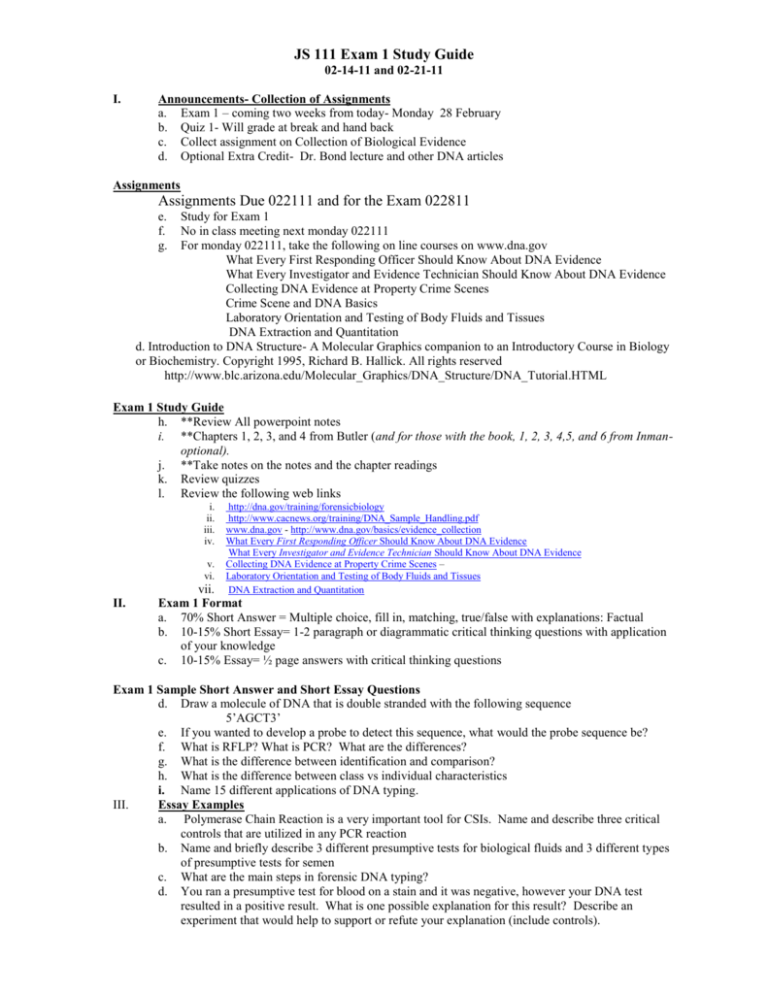
JS 111 Exam 1 Study Guide
02-14-11 and 02-21-11
I.
Announcements- Collection of Assignments
a. Exam 1 – coming two weeks from today- Monday 28 February
b. Quiz 1- Will grade at break and hand back
c. Collect assignment on Collection of Biological Evidence
d. Optional Extra Credit- Dr. Bond lecture and other DNA articles
Assignments
Assignments Due 022111 and for the Exam 022811
e.
f.
g.
Study for Exam 1
No in class meeting next monday 022111
For monday 022111, take the following on line courses on www.dna.gov
What Every First Responding Officer Should Know About DNA Evidence
What Every Investigator and Evidence Technician Should Know About DNA Evidence
Collecting DNA Evidence at Property Crime Scenes
Crime Scene and DNA Basics
Laboratory Orientation and Testing of Body Fluids and Tissues
DNA Extraction and Quantitation
d. Introduction to DNA Structure- A Molecular Graphics companion to an Introductory Course in Biology
or Biochemistry. Copyright 1995, Richard B. Hallick. All rights reserved
http://www.blc.arizona.edu/Molecular_Graphics/DNA_Structure/DNA_Tutorial.HTML
Exam 1 Study Guide
h. **Review All powerpoint notes
i. **Chapters 1, 2, 3, and 4 from Butler (and for those with the book, 1, 2, 3, 4,5, and 6 from Inmanoptional).
j. **Take notes on the notes and the chapter readings
k. Review quizzes
l. Review the following web links
i.
ii.
iii.
iv.
v.
vi.
II.
http://dna.gov/training/forensicbiology
http://www.cacnews.org/training/DNA_Sample_Handling.pdf
www.dna.gov - http://www.dna.gov/basics/evidence_collection
What Every First Responding Officer Should Know About DNA Evidence
What Every Investigator and Evidence Technician Should Know About DNA Evidence
Collecting DNA Evidence at Property Crime Scenes –
Laboratory Orientation and Testing of Body Fluids and Tissues
DNA Extraction and Quantitation
vii.
Exam 1 Format
a. 70% Short Answer = Multiple choice, fill in, matching, true/false with explanations: Factual
b. 10-15% Short Essay= 1-2 paragraph or diagrammatic critical thinking questions with application
of your knowledge
c. 10-15% Essay= ½ page answers with critical thinking questions
Exam 1 Sample Short Answer and Short Essay Questions
d. Draw a molecule of DNA that is double stranded with the following sequence
5’AGCT3’
e. If you wanted to develop a probe to detect this sequence, what would the probe sequence be?
f. What is RFLP? What is PCR? What are the differences?
g. What is the difference between identification and comparison?
h. What is the difference between class vs individual characteristics
i. Name 15 different applications of DNA typing.
III.
Essay Examples
a. Polymerase Chain Reaction is a very important tool for CSIs. Name and describe three critical
controls that are utilized in any PCR reaction
b. Name and briefly describe 3 different presumptive tests for biological fluids and 3 different types
of presumptive tests for semen
c. What are the main steps in forensic DNA typing?
d. You ran a presumptive test for blood on a stain and it was negative, however your DNA test
resulted in a positive result. What is one possible explanation for this result? Describe an
experiment that would help to support or refute your explanation (include controls).









